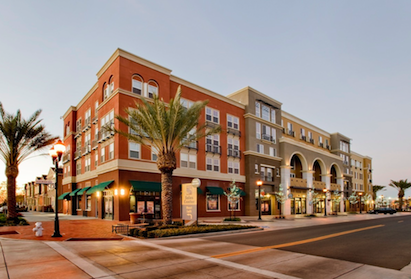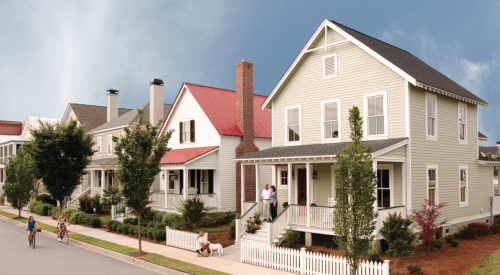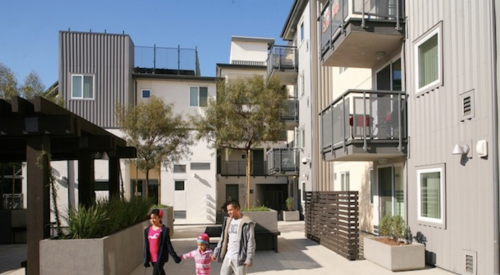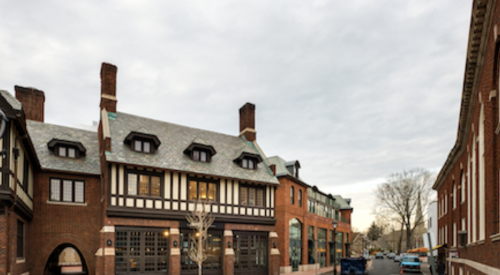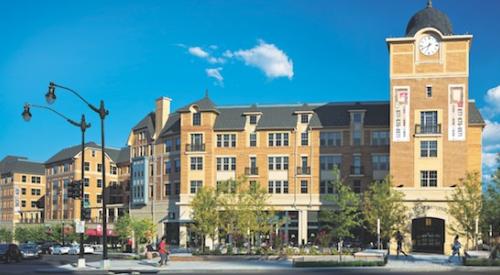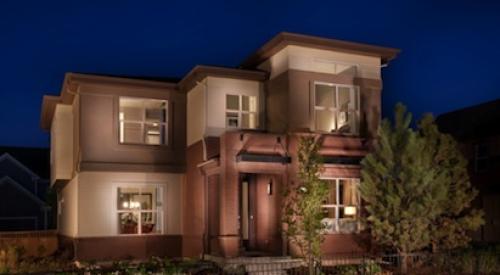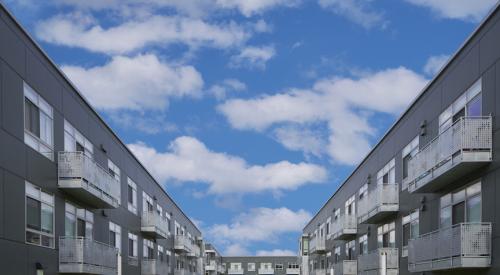The housing-market slowdown has shifted consumer preferences for neighborhood and community features. Instead of large-scale residential developments, the new norm is small infill projects with access to public transportation and commercial opportunities. In many cases, these projects feature a mix of uses, such as retail and office, as well as residential.
According to the American Institute of Architects’ third-quarter 2011 Home Design Trends Survey, mixed-use infill development — typically in more mature communities where the transportation and services infrastructure already exists — has been more successful at competing with foreclosures than new homes in residential-only developments. Fifty-three percent of respondents to the AIA survey said mixed-use projects were increasing in popularity, compared to 49 percent in the 2010 survey.
The uptick in mixed-use development ties into efforts by cities across the U.S. to revitalize their downtown areas and close-in suburbs. Such projects can be a big shot in the arm for neighborhoods in transition.
What makes mixed-use work
- Housing that fills an unmet or underserved need
- The right type of commercial tenants
- Quality finishes and building amenities
- Proximity to public transportation
- Architecture that respects the heritage of the neighborhood
Builders and developers, however, must be careful to select commercial tenants that are appropriate for the neighborhood. As with any infill development, the new architecture should be compatible with what’s already there. Building amenities need to be up to the standards of prospective home buyers or renters. And there are other issues to work out such as density, parking, and accessibility, so it’s critical to get town planners as well as neighbors on board early.
Bringing Back the Workforce
Vidrio almost didn’t happen. The mixed-use project in downtown Pittsburg, Calif., ground to a halt in 2008 when the original developer defaulted. “We were working toward the goal of completing Vidrio until the economic downturn changed everything,” says Garrett Evans, assistant city manager.
The city, which had provided some of the gap financing for the project, purchased it from the bank and brought back general contractor Johnstone Moyer of San Mateo, Calif., to finish the job. “It was 80 to 85 percent complete at that point,” Evans says.
As part of an ongoing redevelopment effort, the city was planning to make over three city blocks in Pittsburg’s Old Town district. “All three blocks were cleared, but we ended up building only the middle block,” he says.
Pittsburg has traditionally been the industrial hub of Contra Costa County and is still home to Dow Chemical, U.S. Steel, and several power plants. Now Evans describes it as a community in transition. “It still has industry, but we’re starting to see more commuters who work in San Francisco and Oakland,” he says, adding that Pittsburg is the final stop on the Bay Area Rapid Transit line.
The Dahlin Group of Pleasanton, Calif., designed Vidrio with homes above ground-floor commercial space on two sides. The other two sides have an entirely residential presence, with a central courtyard and recreation building. “The term I always heard was, ‘built over time,’” says Dahlin’s Glen Simmons. “The city wanted Vidrio to fit in with the architectural heritage of older buildings, so that’s where we got our ideas.”
The residences include lofts, flats, and townhomes. The lofts are popular because they’re on the top floor, with a two-story wall of glass overlooking the street, says Simmons.
With market-rate prices starting in the low $100,000s, the 75 homes at Vidrio sold quickly. “Quite a few teachers bought the homes, as well as firefighters and police officers,” Evans says. “We were very glad to see the workforce population coming back.”
A Town Center Is Born
In Milton, Mass., a bedroom community just outside of Boston, the Residences at Brook Hill finally opened in June after more than 10 years of public and private efforts to revive the town’s central business district. No significant investment had been made in the CBD for 60 years, yet it was bordered by residential neighborhoods with million-dollar homes.
“The CBD was dark and void of life,” says Michael Roberts, managing partner for development firm Milton Partners. “It had a pizza parlor, a liquor store, and a sandwich shop, but it was dying because it had lost its core population.”
Thirty years ago, Roberts says, the district was dominated by an ice-cream factory, an automobile dealership, and a police station. Then, the factory and auto dealership closed down and the police station relocated to another part of town. A municipal parking lot was built on the police-station site.
Roberts and his partner, Paul Sullivan, acquired the parking lot in 2002 after much discussion with town officials and local residents. It wasn’t until 2006 that zoning changes were approved to allow mixed use. Milton Partners sold the property in 2010 to builder and current owner Oranmore Enterprises, Dorchester, Mass.
Brook Hill is a four-story building with 18 condominiums ranging from 1,169 to 1,915 square feet, along with three street-level commercial spaces. Sixteen condominiums are being sold at market-rate prices ($379,000 to $599,000); the other two have been designated as affordable housing. Roberts says about 75 percent of the homes are sold. One of the commercial spaces has been leased to a wellness spa.
Just across the road is a streetcar that transports commuters to the subway line into Boston. Because Brook Hill replaced the town parking lot, the developers had to provide underground parking as well as surface parking — 49 spaces in all.
As for the architecture, “We wanted to create a beautiful edge to a square that was badly frayed,” says architect Andrew Zalewski, president of the MZO Group, Stoneham, Mass. “The sidewalk actually slopes downhill as it passes the site, so I wanted to handle the accessibility issue gracefully.” Zalewski’s “front porch” concept brings the commercial spaces close to the sidewalk and makes the residential space accessible without ramps or other specialty items.
The subterranean parking garage determined the footprint of the building and is the reason all of the condominium plans are slightly different. In most units, the master bedroom is separated from the secondary bedrooms — a configuration that is especially popular with unrelated singles sharing a home, says Zalewski.
Buyers are primarily empty nesters who are selling their big homes in Milton and dual-income couples without children who want to live close to Boston.
Roberts sees the project as a significant step in attracting private investment to help revitalize the Central Avenue Business District and other underutilized areas within Milton. The factory and former car dealership (now an ambulance-service building) are being redeveloped as mixed-use properties. Government-funded infrastructure improvements such as new sidewalks and street lights are also contributing to the area’s rebirth.
“Mixed use alone didn’t sell it,” says Roberts. “It took tremendous diplomacy and concessions to the neighbors and the town to make the project happen.”
Upscale Digs for the College Crowd
Over the past 20 years, the University of Southern California has evolved from a commuter school into a nationally and internationally recognized academic institution. USC decided new housing adjacent to its Los Angeles campus was in order if the school was to remain competitive.
“Most of the student housing north of campus is older construction from the 1950s and 1960s,” says David Hilliard of Symphony Development, Los Angeles. “Some old single-family homes have also been converted into student housing, which has been anathema to the neighborhood.”
Symphony Development spotted an opportunity for a new project at the intersection of Figueroa and West 27th. The Figueroa corridor connects USC to downtown Los Angeles, the Staples Center, the convention center, and other destinations. “The whole corridor is being revitalized with housing and other amenities that make it much livelier than it has been over the last 40 years,” says Hilliard.
Symphony and its equity partner, Los Angeles-based CityView, developed a mixed-use community, West 27th Place, with 161 apartments and 10,000 square feet of shops and restaurants. The apartments range from 425 to 1,364 square feet and include studios and one- to four-bedroom units. The community had its grand opening in August and all of the apartments have been leased to date. Two commercial tenants have signed leases so far: Five Guys Burgers and Fries and the Original Brooklyn Water Bagel Company.
“We’re talking to other types of tenants, such as financial services and cellular phone providers, but the most demand is for food,” says Hilliard.
Con Howe, managing director of the CityView Los Angeles Fund, points out that the building is one block from a new stop on the city’s light-rail line. “Within two years, some of the street improvements being done on Figueroa are going to include a separate bike lane, so it will be very safe and convenient to bike to and from the campus and downtown,” Howe says.
Those for whom college life is a distant memory would be amazed at what West 27th Place has to offer: 11,000 square feet of ground-level retail space; a swimming pool and spa; a 350-bicycle storage room; study rooms on every floor; a recreation room with big-screen TVs; and a full-service fitness center. Every apartment is fully furnished and has its own dedicated broadband and Wi-Fi service.
The seven-story, Mission-style building was designed by Clark & Hedrick, an architectural firm in Los Angeles that has since closed its doors. Principal architect Keith Dover, who currently practices in Salt Lake City, took his design cues from three adjacent historic buildings: the Automobile Club of Southern California and two Catholic churches.
“We had to be good neighbors because our building was taller,” says Dover. He used windows and breaks in the roofline to lighten the massiveness of the structure. “Balconies were omitted on the side that faces St. Mark’s, but we kept the recesses for the undulation of the building. I also made the top floors more articulated and the bottom heavier.”
West 27th Place is the only student-housing project in the U.S. to achieve LEED Platinum certification. Features include an elevator with a regenerative drive that feeds energy back into the grid; drought-tolerant landscaping; Energy Star appliances; low-flow plumbing fixtures; and formaldehyde-free furniture. The builder, Cobalt Construction of Simi Valley, Calif., generated 95 percent less waste during construction compared to similar projects, Hilliard says.
